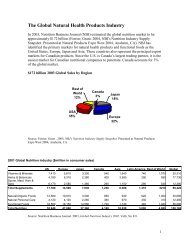Beyond Borders: Global biotechnology report 2010
Beyond Borders: Global biotechnology report 2010
Beyond Borders: Global biotechnology report 2010
You also want an ePaper? Increase the reach of your titles
YUMPU automatically turns print PDFs into web optimized ePapers that Google loves.
A closer look<br />
Uncertain by design: preparing for outcomes-based<br />
pricing arrangements<br />
As pricing pressures have intensified in recent years, outcomesbased<br />
pricing arrangements have become increasingly visible<br />
in some markets. These agreements represent a paradigm shift<br />
for the industry, since they reimburse drug companies based<br />
not on how many units of a product they sell, but rather on<br />
how effective those products are in delivering health-related<br />
outcomes. With health care reform initiatives in many countries<br />
intensifying the focus on health care costs, such arrangements<br />
could become even more common. <strong>Beyond</strong> the strategic<br />
implications, these arrangements also present operational<br />
challenges for drug companies.<br />
Data matters<br />
A recent <strong>report</strong> by Datamonitor classifies outcomes-based<br />
pricing arrangements into three broad categories: clinical<br />
risk-sharing, where a payor receives a refund from the<br />
manufacturer if the drug fails to meet clinical outcomes; costeffectiveness<br />
risk-sharing, where a payor receives a refund<br />
if cost-effectiveness targets are not met; and fixed budget,<br />
price or volume agreements, where the amount a payor pays<br />
is limited by provisions such as price caps, utilization caps and<br />
budget caps.<br />
Clinical risk-sharing arrangements, in particular, carry significant<br />
data-collection challenges. To track and evaluate outcomes,<br />
companies must maintain large volumes of relevant patientlevel<br />
data, without which they may be exposed to significant<br />
reimbursement risk. The data collected needs to permit<br />
reliably measuring clinical results — which may not be easily<br />
accomplished for every therapy.<br />
To address these challenges, companies should consider<br />
several factors:<br />
• Pick the right measure. Performance measures should be<br />
selected carefully based on clinical-trial results and postmarketing<br />
studies. Measures should lend themselves to<br />
objective evaluation, since guarantees based on subjective<br />
measures or long evaluation periods could lead to commercial<br />
disputes with payors over outcomes, require maintaining<br />
significant outcomes data for extended periods and raise the<br />
potential for long-term revenue deferral.<br />
• Monitor patients. Companies should consider effective<br />
patient monitoring and assistance programs to facilitate<br />
92 <strong>Beyond</strong> borders <strong>Global</strong> <strong>biotechnology</strong> <strong>report</strong> <strong>2010</strong><br />
Anthony Masherelli<br />
Ernst & Young LLP<br />
patient compliance, which can increase the likelihood of<br />
favorable outcomes.<br />
• Boost information technology and management. Companies<br />
will need to ensure that their information technology (IT)<br />
systems are up to these challenges. Existing systems may<br />
need to be upgraded to track the right metrics. Information<br />
management is also important. Financial <strong>report</strong>ing personnel<br />
will likely need greater access to clinical outcomes data to<br />
account for outcomes-based arrangements, and companies<br />
will need to facilitate data access while protecting patient<br />
privacy. And since this data may become a critical input into<br />
the financial <strong>report</strong>ing process, firms will need controls to<br />
ensure information is complete and accurate.<br />
Accounting implications<br />
It’s not surprising that outcomes-based pricing arrangements<br />
raise significant revenue recognition challenges. How much<br />
revenue can a company recognize — and when can it recognize<br />
it — in an arrangement where there is tremendous uncertainty<br />
about how much it will ultimately be paid?<br />
As is often the case, the answer will ultimately depend on<br />
the specific facts and circumstances of each arrangement. In<br />
some cases, companies will need to defer revenue until patient<br />
outcomes are known or can be reliably estimated. In others,<br />
they may be able to recognize full or partial revenues at the<br />
time of sale.<br />
In some arrangements (particularly those involving clinical risk<br />
sharing) the timing of revenue recognition will depend on a<br />
company’s ability to estimate, at the time of sale, the revenue it<br />
will ultimately receive in connection with a sale — in other words,<br />
whether the arrangement fee is fixed or determinable (US<br />
GAAP) or can be measured reliably (IFRS) at the time of sale.<br />
Depending on the nature of the arrangement, this determination<br />
may prove challenging.<br />
Given current industry trends, it seems inevitable that we will<br />
see more outcomes-based pricing arrangements over time. It<br />
is also inevitable that these structures bring more uncertainty<br />
for companies. To manage this risk, firms should consider<br />
accounting implications up front and should align program<br />
design to the availability of clinically relevant information and<br />
IT capabilities.








